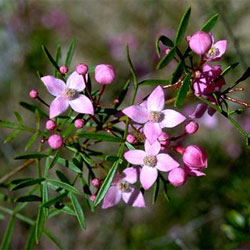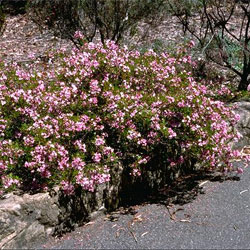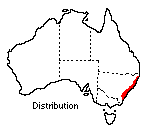Boronia pinnata
 |
 |
Pinnate Boronia
Many gardeners, whether native plant enthusiasts or not, wish to grow Australia's beautiful Boronias, including the fragrant brown Boronia megastigma which is not always long lasting. Boronia pinnata however, described here, is a tougher species and can be long-lived in a sheltered spot and with light trimming.
 This Boronia is a beautiful waxy-flowered delicate shrub, not sweetly
perfumed but with aromatic leaves. An interesting scent is noticed close to
the flowers, but it does not scent the air.
This Boronia is a beautiful waxy-flowered delicate shrub, not sweetly
perfumed but with aromatic leaves. An interesting scent is noticed close to
the flowers, but it does not scent the air.
This is one of the common Boronia species of sandstone country in New South Wales up to lower mountain levels. It grows in dry sclerophyll forests and in well-drained sandy heaths where crowded among other shrubs it can be over 1.5 m high, slender and arching.
The species varies and can be very soft with weeping tips and pale mauve flowers , occasionally white. A slightly more robust and upright form is often seen with stems or leaves tinged purple and with light purple flowers. During August the clear, bright colours are visible from a distance. A dark-flowered prostrate form is also available.
As Boronia pinnata is very similar to several other Boronia species, with slight differences such as fine hairs on young growth, it was formerly recorded as growing in other eastern states. In present classification it is considered a New South Wales species only.
Plant form may be low or spreading, encouraged if desired by trimming. The foliage of a sheltered plant is ornamental and ferny, light to mid-green. The leaves are up to 25 mm long, opposite, and with several pairs of widely spaced leaflets. All parts of the plant are delicate, hairless and waxy.
A setting among rocks is useful for keeping the root area cool. The plants
may be broken or spoilt by intense sun or strong winds. If it is felt that no
position in the garden is sheltered enough, it may be possible to grow the shrub
in a tub or large pot, moved into the shade as necessary. It was as pot plants
that Boronia species were first widely grown in Europe after discovery.
Flowering starts in early September in Canberra and can last till early December;
it is at its best throughout October. The flowers are clustered on slender stems,
roundish buds opening to cups about 1 cm diameter and of four pointed petals.
The quality is waxy and translucent, the colours pure hues and tints. Some seed
sets in Canberra; however, cuttings are generally used in propagation, taking
half-ripe tip growth in early summer or later.
Boronias are generally long-lasting as cut flowers, and by taking short sprays for the house this species is given the little trimming it needs to avoid bare wood.
Text by ANBG staff (1974)
Name meaning: Boronia pinnataBoronia - after F. Borone, an Italian plant collector 1769-94; |
![An Australian Government Initiative [logo]](/images/austgovt_brown_90px.gif)

